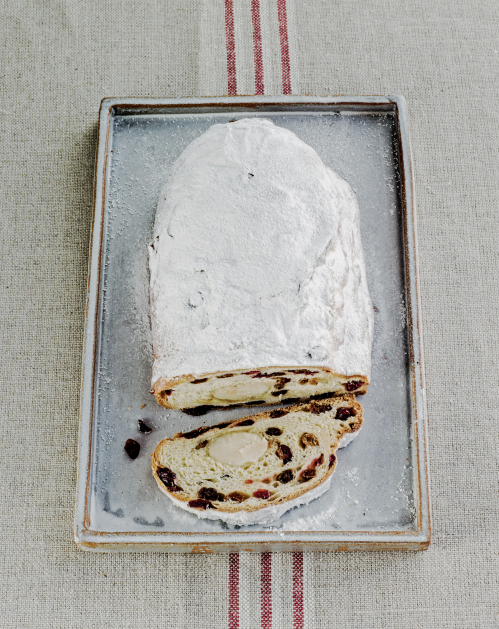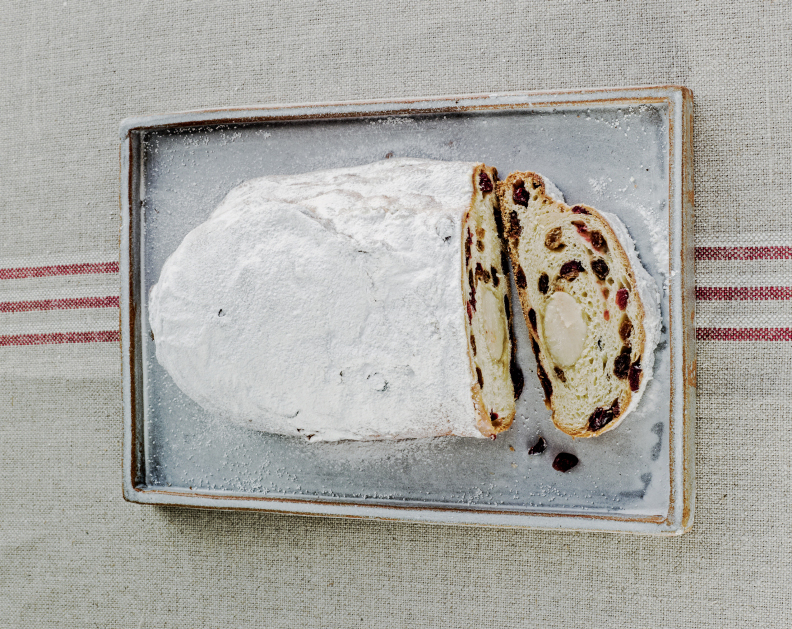
Cranberries are synonymous with the holiday season, and cranberry stollen is an exciting new way for many at-home bakers to show off their skills. This recipe is a part of a series from the cookbook What to Bake & How to Bake It, from which we’ve also featured recipes for carrot cake with cream cheese frosting and iced gingerbread cookies.
Cranberry Stollen
Preparation time: 45 minutes, plus rising, proofing, and cooling
Baking time: 30 minutes
Makes: 2 family-size loaves
Several wintry trips to Germany have given me a real fondness for stollen, the richly fruited Christmas loaf with the hidden treasure of marzipan inside. The recipe makes two loaves; eat one straight after baking, then wrap the other one well and stash it in the freezer for up to 1 month.
INGREDIENTS
For the bread:
- 1 lemon
- ¼ cup rum (or use orange juice)
- 1 tsp vanilla extract
- 1 cup dried cranberries
- 1 cup golden raisins (or use chopped dried apricots)
- 1¼ cups milk
- 1 tbsp instant dry yeast
- 1 whole nutmeg, or use 1 tsp ground
- 4 cups bread flour, plus extra for kneading
- 1 tsp salt
- ⅓ cup sugar
- 1½ sticks (¾ cup) butter
- 2 eggs
- 9 oz marzipan
- To finish:
- ½ stick (¼ cup) butter
- ¼ cup confectioners’ sugar
INSTRUCTIONS
- Finely grate the lemon zest and mix it with the rum or orange juice, vanilla, and dried fruit. Let macerate while you make the dough. Gently warm the milk in the microwave or in a pan, then whisk in the yeast. The milk must only be warm; if it’s too hot, it will kill the yeast.
- If using whole nutmeg, grate 2 teaspoons. Sift the flour into a large bowl with the salt, then add the nutmeg and sugar. Cut the butter into cubes, then rub it into the flour mixture using your fingertips, until the mixture looks like breadcrumbs.
- Separate one of the eggs (see page 127). Add the yolk and whole egg to the milk and beat together. Using a wooden spoon, mix the liquid into the rubbed-in mixture to make a soft, sticky dough. Let stand for 10 minutes.
- Dust the work surface with flour, then turn the dough out onto it. Flour the top of the dough and your hands, then begin to knead (see page 69 for guidance). Keep going for about 10 minutes, until the dough feels very springy or elastic and silky smooth. Use more flour if you need to. Put the dough in an oiled bowl and cover with oiled plastic wrap.
- Let rise in a warm place for about 1½ hours, or until doubled in size.
- Turn the dough out onto the floured work surface and cut it in half. Use your hands to press and pat each half into a rectangle about 8 x 15 inches. Spread the soaked fruit over the bottom half of each rectangle, then fold the top half over it.
- Pat the dough out to about 6 x 10 inches, then fold it in half again along the long edge; repeat this twice, or until the fruit is well distributed in the dough, but isn’t escaping. You should end up with 2 rectangles about 6 x 10 inches.
- If at any point it starts being too springy to handle, let it sit for a few minutes, then continue.
- Roll the marzipan into 2 equal sausages. Make a deep groove along the length of each piece of dough, then place the marzipan in it.
- Roll the left side of the dough over the marzipan. Press and pinch the edges together well to make a lip of dough, then shape the ends of the loaves into slight points.
- Line a large baking sheet with parchment paper and lift the breads onto it. Leave room for rising. Cover with oiled plastic wrap and let proof in a warm place for 1 hour, or until almost doubled in size. Preheat the oven to 350°F.
- Bake for 30 minutes, or until the breads have risen well and are dark golden brown. Melt the butter, then brush it all over the warm stollen and dredge with confectioners’ sugar.
- Let cool completely before wrapping and storing. Dust with sugar again before bringing it to the table.



